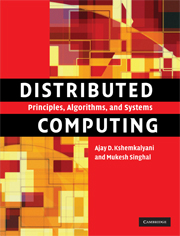Book contents
- Frontmatter
- Contents
- Preface
- 1 Introduction
- 2 A model of distributed computations
- 3 Logical time
- 4 Global state and snapshot recording algorithms
- 5 Terminology and basic algorithms
- 6 Message ordering and group communication
- 7 Termination detection
- 8 Reasoning with knowledge
- 9 Distributed mutual exclusion algorithms
- 10 Deadlock detection in distributed systems
- 11 Global predicate detection
- 12 Distributed shared memory
- 13 Checkpointing and rollback recovery
- 14 Consensus and agreement algorithms
- 15 Failure detectors
- 16 Authentication in distributed systems
- 17 Self-stabilization
- 18 Peer-to-peer computing and overlay graphs
- Index
12 - Distributed shared memory
Published online by Cambridge University Press: 05 June 2012
- Frontmatter
- Contents
- Preface
- 1 Introduction
- 2 A model of distributed computations
- 3 Logical time
- 4 Global state and snapshot recording algorithms
- 5 Terminology and basic algorithms
- 6 Message ordering and group communication
- 7 Termination detection
- 8 Reasoning with knowledge
- 9 Distributed mutual exclusion algorithms
- 10 Deadlock detection in distributed systems
- 11 Global predicate detection
- 12 Distributed shared memory
- 13 Checkpointing and rollback recovery
- 14 Consensus and agreement algorithms
- 15 Failure detectors
- 16 Authentication in distributed systems
- 17 Self-stabilization
- 18 Peer-to-peer computing and overlay graphs
- Index
Summary
Abstraction and advantages
Distributed shared memory (DSM) is an abstraction provided to the programmer of a distributed system. It gives the impression of a single monolithic memory, as in traditional von Neumann architecture. Programmers access the data across the network using only read and write primitives, as they would in a uniprocessor system. Programmers do not have to deal with send and receive communication primitives and the ensuing complexity of dealing explicitly with synchronization and consistency in the messagepassing model. The DSM abstraction is illustrated in Figure 12.1. A part of each computer's memory is earmarked for shared space, and the remainder is private memory. To provide programmers with the illusion of a single shared address space, a memory mapping management layer is required to manage the shared virtual memory space.
DSM has the following advantages:
Communication across the network is achieved by the read/write abstraction that simplifies the task of programmers.
A single address space is provided, thereby providing the possibility of avoiding data movement across multiple address spaces, and simplifying passing-by-reference and passing complex data structures containing pointers.
If a block of data needs to be moved, the system can exploit locality of reference to reduce the communication overhead.
DSM is often cheaper than using dedicated multiprocessor systems, because it uses simpler software interfaces and off-the-shelf hardware.
There is no bottleneck presented by a single memory access bus.
[…]
- Type
- Chapter
- Information
- Distributed ComputingPrinciples, Algorithms, and Systems, pp. 410 - 455Publisher: Cambridge University PressPrint publication year: 2008



